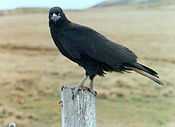Striated caracara
| Striated caracara | |
|---|---|
.jpg) | |
| Conservation status | |
| Scientific classification | |
| Kingdom: | Animalia |
| Phylum: | Chordata |
| Class: | Aves |
| Order: | Falconiformes |
| Family: | Falconidae |
| Genus: | Phalcoboenus |
| Species: | P. australis |
| Binomial name | |
| Phalcoboenus australis (Gmelin, 1788) | |
The striated caracara, (Phalcoboenus australis) is a bird of prey of the family Falconidae. In the Falkland Islands it is known as the Johnny rook.
Description
The adults' plumage is almost black in colour, while the legs and lores are orange and the neck is flecked with grey. The first year juveniles have an orange or light red down, which they lose after their first molt. Full adult plumage is acquired only in the fifth year.
Distribution and habitat
It breeds in several islands in Tierra del Fuego, but is more abundant in the Falklands. Though it was once considered common in the Falklands archipelago, it now only nests in the outlying islands where it breeds around penguin and albatross colonies.
Behaviour
Feeding
The striated caracara is primarily a scavenger, feeding on carrion, mainly dead seabirds and dead sheep, offal and food scraps. It occasionally takes insects and earthworms that it digs up with its claws. However it will also prey on weak or injured creatures, such as young seabirds. Its habit of attacking newborn lambs and weakened sheep has led it to be ruthlessly persecuted by sheep farmers.
Often it is known to steal red objects such as clothing or handkerchiefs, possibly because red is the colour of meat. Like all falconiformes it has excellent colour vision which easily surpasses that of any known mammal.[2] Often it will also raid dustbins and move rocks to get food from underneath, thus proving themselves to be one of the most intelligent of the birds of prey.
Breeding
The nest is built on the ground or on a cliff ledge, where the female will lay up to 4 eggs. Their hatching is timed to coincide with the nesting season of seabirds, providing a constant food supply for the chicks. Once these have fledged, they gather into flocks and roam through the islands, often close to human settlements.
Status and conservation
The population in the Falklands is estimated at 500 breeding pairs. Juveniles and indeed, adults, are almost entirely fearless of humans and treat their approach with indifference. Over time, conflict with the sheep farmers has led to a great reduction in their numbers. This is now being corrected by the Falkland Islanders.
Gallery
-
.jpg)
Striated caracara feeding on a dead gentoo penguin chick
-

-

-

-

-

-
-

At Amazona Zoo, Norfolk, England
References
- ↑ BirdLife International (2012). "Phalcoboenus australis". IUCN Red List of Threatened Species. Version 2013.2. International Union for Conservation of Nature. Retrieved 26 November 2013.
- ↑ Understanding the Bird of Prey by Dr. Nick Fox
External links
| Wikimedia Commons has media related to Phalcoboenus australis. |
- Striated caracara videos on the Internet Bird Collection
- Stamps (Issues for Falkland Islands) with S. America RangeMap

